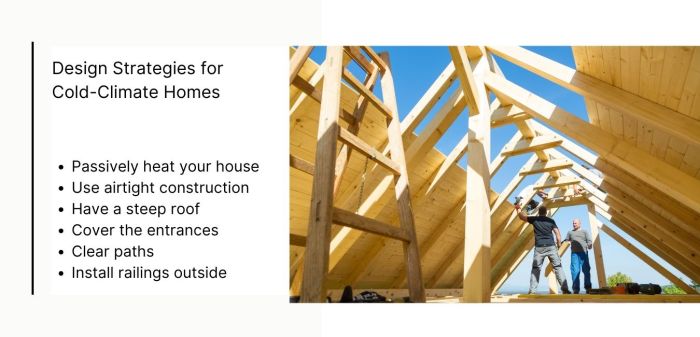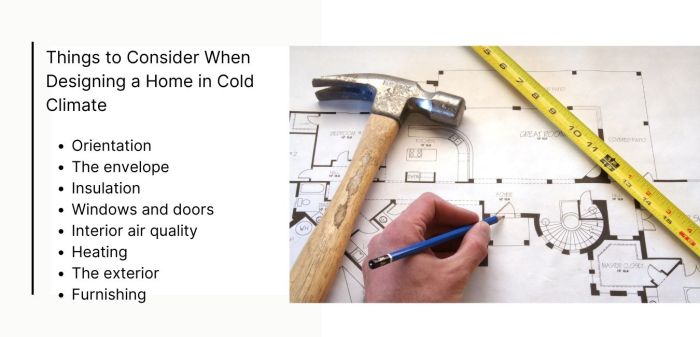As Northern Home Improvement Design Trends for Cold Climates takes center stage, this opening passage beckons readers into a world crafted with good knowledge, ensuring a reading experience that is both absorbing and distinctly original. From unique challenges to innovative solutions, this guide delves into the realm of designing homes for cold climates with a focus on insulation, energy efficiency, and captivating design trends that set Northern regions apart.
Northern Home Improvement Design Trends for Cold Climates
In cold climates, designing homes comes with unique challenges that require specific considerations to ensure comfort and energy efficiency.
Insulation plays a crucial role in cold weather regions, helping to retain heat indoors and reduce energy consumption. Proper insulation can also prevent issues like frozen pipes and drafty rooms.
Design trends in Northern regions often prioritize functionality and durability to withstand harsh weather conditions. This can include features like high-performance windows, energy-efficient heating systems, and well-sealed doors.
Materials and Colors for Cold Climate Home Design
- Materials like stone, brick, and wood are popular choices for exterior finishes in cold climates due to their durability and ability to provide insulation.
- Dark colors, such as deep greens and rich browns, are often used on exteriors to absorb sunlight and retain heat during colder months.
- For interiors, warm and cozy colors like earth tones and shades of blue can create a welcoming atmosphere and complement the overall cold climate design aesthetic.
Exterior Design Trends

In cold climates, exterior design trends focus on both aesthetics and functionality to withstand harsh weather conditions while enhancing the overall look of homes.
Durable Materials for Harsh Weather
- One popular trend is using durable materials like fiber cement siding, stone veneer, and metal roofing that can withstand extreme cold, snow, and ice.
- These materials not only provide protection but also add a modern and sleek look to the exterior of homes.
- They require minimal maintenance and have a longer lifespan, making them ideal for cold climate regions.
Landscaping Ideas for Northern Regions
- In cold climates, landscaping should be designed to complement the exterior of homes and thrive in harsh conditions.
- Native plants like evergreen trees, shrubs, and cold-resistant flowers are popular choices for landscaping in Northern regions.
- Rock gardens, gravel pathways, and winter-friendly outdoor lighting can also enhance the curb appeal of homes in cold climates.
Common Architectural Styles in Cold Climate Areas
- Architectural styles like Craftsman, Scandinavian, and Modern Farmhouse are commonly seen in cold climate areas.
- These styles often feature steep roofs, overhangs to prevent snow buildup, and large windows to maximize natural light and warmth.
- Exterior elements like wood accents, stone facades, and metal details are also popular in these architectural styles.
Interior Design Trends

Creating a warm and cozy atmosphere is essential in homes located in cold climates. Let's explore some interior design trends that can help achieve this while maximizing comfort and style.
Importance of Natural Light
Natural light plays a crucial role in homes in cold climates, as it not only helps to brighten up spaces but also contributes to a feeling of warmth and openness. Large windows, skylights, and strategically placed mirrors can help maximize natural light and create a welcoming ambiance.
Use of Textures and Fabrics
Incorporating textures and fabrics like wool, faux fur, and knits can add layers of coziness to the interior design of Northern homes. Consider adding throw blankets, area rugs, and plush cushions to create a warm and inviting environment.
Innovative Heating Solutions
When it comes to heating solutions, consider options that not only provide warmth but also blend seamlessly with the interior design of your home. Radiant floor heating, electric fireplaces, and heated towel racks are innovative choices that can enhance comfort while maintaining a stylish aesthetic.
Sustainable Design Practices

When it comes to designing homes in cold climate regions, incorporating sustainable practices is crucial for reducing environmental impact and increasing energy efficiency. By utilizing eco-friendly materials and construction techniques, homeowners can create a more sustainable living space that is both comfortable and environmentally friendly.
Benefits of Eco-Friendly Materials and Techniques
- Choosing materials such as reclaimed wood, recycled glass, and bamboo can help reduce the carbon footprint of a home.
- Implementing proper insulation and energy-efficient windows can significantly lower heating costs and reduce energy consumption.
- Utilizing passive solar design techniques, such as strategically placing windows to maximize sunlight, can help naturally heat the home during colder months.
Integration of Renewable Energy Sources
- Installing solar panels or a geothermal heating system can provide a sustainable energy source that reduces reliance on traditional fossil fuels.
- Wind turbines can also be considered for homes in windy areas to generate clean energy.
- Using energy-efficient appliances and lighting fixtures can further reduce energy consumption and promote sustainability.
Green Building Certifications
- Homeowners in cold climates can consider certifications like LEED (Leadership in Energy and Environmental Design) or Passive House certification to ensure their homes meet high standards of sustainability.
- The Energy Star label is another certification to look for when choosing energy-efficient products for the home.
- Building with sustainable materials and following green building practices can help homeowners achieve these certifications and contribute to a healthier environment.
Ultimate Conclusion
In conclusion, Northern Home Improvement Design Trends for Cold Climates offer a blend of functionality, comfort, and sustainability. From exterior to interior design, embracing the essence of warmth and eco-friendliness creates spaces that truly stand out in colder regions. By incorporating these trends and practices, homeowners can elevate their living spaces to new heights of style and resilience against the cold.
Questions Often Asked
What are some common challenges in designing homes for cold climates?
Common challenges include ensuring proper insulation, energy efficiency, and selecting materials that can withstand harsh weather conditions.
How important is natural light in homes located in cold climates?
Natural light is crucial in cold climates to create a sense of warmth and brightness, especially during long winter months.
What are some sustainable design practices relevant to cold climate regions?
Sustainable practices include using eco-friendly materials, integrating renewable energy sources, and aiming for green building certifications.













